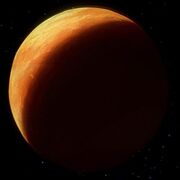(Undo revision 1133948 by 207.216.48.19 (talk); non-canon) |
(→External link: Added memory beta link.) |
||
| (19 intermediate revisions by 14 users not shown) | |||
| Line 1: | Line 1: | ||
| + | {{multiple}} |
||
| − | [[File:Vulcan, |
+ | [[File:Vulcan, 2285.jpg|thumb|A planet ({{dis|Vulcan|planet}})]] |
| − | '''Planet''' |
+ | '''Planet''', also known as a '''planetary body''' or '''world''', is the common designation for a certain type of celestial body usually orbiting a [[star]]. They occurred in a great variety of different compositions, masses, and surface conditions. The exact definition of what constituted a planet varied among cultures. |
| − | The final appearance of a planet depended on its formation process, which meant where and under what circumstances it formed. Planets could accumulate gigantic [[atmosphere]]s, exceeding their original size and mass, or they could rest without any atmosphere at all. With a sufficient mass, a planet was able to accumulate so much [[gas]], that it started to undergo [[nuclear fusion]], turning into a [[protostar]]. In this state it began to emit [[energy]], as its core temperature and density increased. Planets could also be changed to a [[ |
+ | The final appearance of a planet depended on its formation process, which meant where and under what circumstances it formed. Planets could accumulate gigantic [[atmosphere]]s, exceeding their original size and mass, or they could rest without any atmosphere at all. With a sufficient mass, a planet was able to accumulate so much [[gas]], that it started to undergo [[nuclear fusion]], turning into a [[protostar]]. In this state it began to emit [[energy]], as its core temperature and density increased. Planets could also be changed to a [[class M]] environment by [[terraforming]]. ({{TNG|Home Soil}}) |
| − | The Federation had numerous different [[planetary classification|classifications for planets]] depending on their mass, composition, surface environment and atmospheric compounds. |
+ | The Federation had numerous different [[planetary classification|classifications for planets]] depending on their mass, composition, surface environment and atmospheric compounds. |
| + | |||
| + | ''In [[2259]], in the [[alternate reality]], when targeted comm bursts were broadcast to distant planets from [[Starfleet]] [[starship]]s, planetary information was displayed on the main viewscreen such as the class and status as a living planet (a planet with life), its moons, the native intelligent species, the [[star system]], [[sector]] and sector block locations. Geographical information was also displayed.'' ({{film|12}} ''display graphic'') |
||
==Types== |
==Types== |
||
| Line 37: | Line 40: | ||
*[[Ninth planets]] |
*[[Ninth planets]] |
||
*[[Tenth planets]] |
*[[Tenth planets]] |
||
| + | *[[Eleventh planets]] |
||
*[[Twelfth planets]] |
*[[Twelfth planets]] |
||
*[[Fourteenth planets]] |
*[[Fourteenth planets]] |
||
*[[Twentieth planets]] |
*[[Twentieth planets]] |
||
| − | ==External |
+ | ==External links== |
| − | *{{wikipedia}} |
+ | * {{wikipedia}} |
| + | * {{Mbeta}} |
||
| ⚫ | |||
[[bg:Планета]] |
[[bg:Планета]] |
||
| Line 53: | Line 57: | ||
[[ja:惑星]] |
[[ja:惑星]] |
||
[[nl:Planeet]] |
[[nl:Planeet]] |
||
| + | [[sr:Планета]] |
||
[[sv:Planet]] |
[[sv:Planet]] |
||
| + | [[es:Planeta]] |
||
| ⚫ | |||
Revision as of 19:09, 10 February 2019
(covers information from several alternate timelines)

A planet (Vulcan)
Planet, also known as a planetary body or world, is the common designation for a certain type of celestial body usually orbiting a star. They occurred in a great variety of different compositions, masses, and surface conditions. The exact definition of what constituted a planet varied among cultures.
The final appearance of a planet depended on its formation process, which meant where and under what circumstances it formed. Planets could accumulate gigantic atmospheres, exceeding their original size and mass, or they could rest without any atmosphere at all. With a sufficient mass, a planet was able to accumulate so much gas, that it started to undergo nuclear fusion, turning into a protostar. In this state it began to emit energy, as its core temperature and density increased. Planets could also be changed to a class M environment by terraforming. (TNG: "Home Soil")
The Federation had numerous different classifications for planets depending on their mass, composition, surface environment and atmospheric compounds.
In 2259, in the alternate reality, when targeted comm bursts were broadcast to distant planets from Starfleet starships, planetary information was displayed on the main viewscreen such as the class and status as a living planet (a planet with life), its moons, the native intelligent species, the star system, sector and sector block locations. Geographical information was also displayed. (Star Trek Into Darkness display graphic)
Types
Lists
All planets are collected in the category Planets. Additionally, several lists for specific groups of planets exist:
- Cardassian planets
- Dominion planets
- Earth colonies
- Federation colonies
- Federation members
- Homeworlds
- Inhabited planets
- Klingon planets
- Delphic Expanse planets
- Romulan planets
- Uninhabited planets
- Unnamed planets
- Prime planets
- First planets
- Second planets
- Third planets
- Fourth planets
- Fifth planets
- Sixth planets
- Seventh planets
- Eighth planets
- Ninth planets
- Tenth planets
- Eleventh planets
- Twelfth planets
- Fourteenth planets
- Twentieth planets
External links
- Planet at Wikipedia
- Planet at Memory Beta, the wiki for licensed Star Trek works
